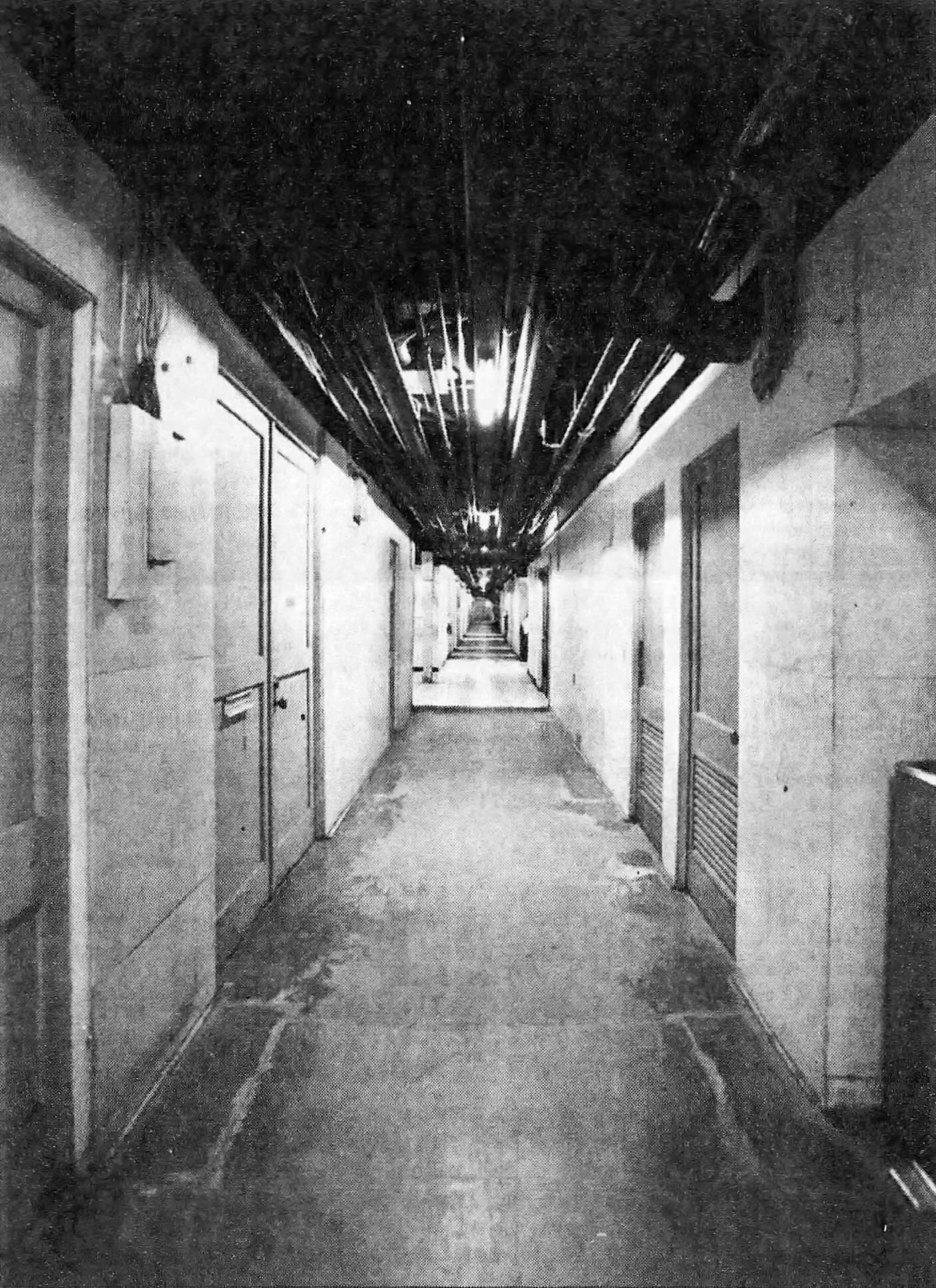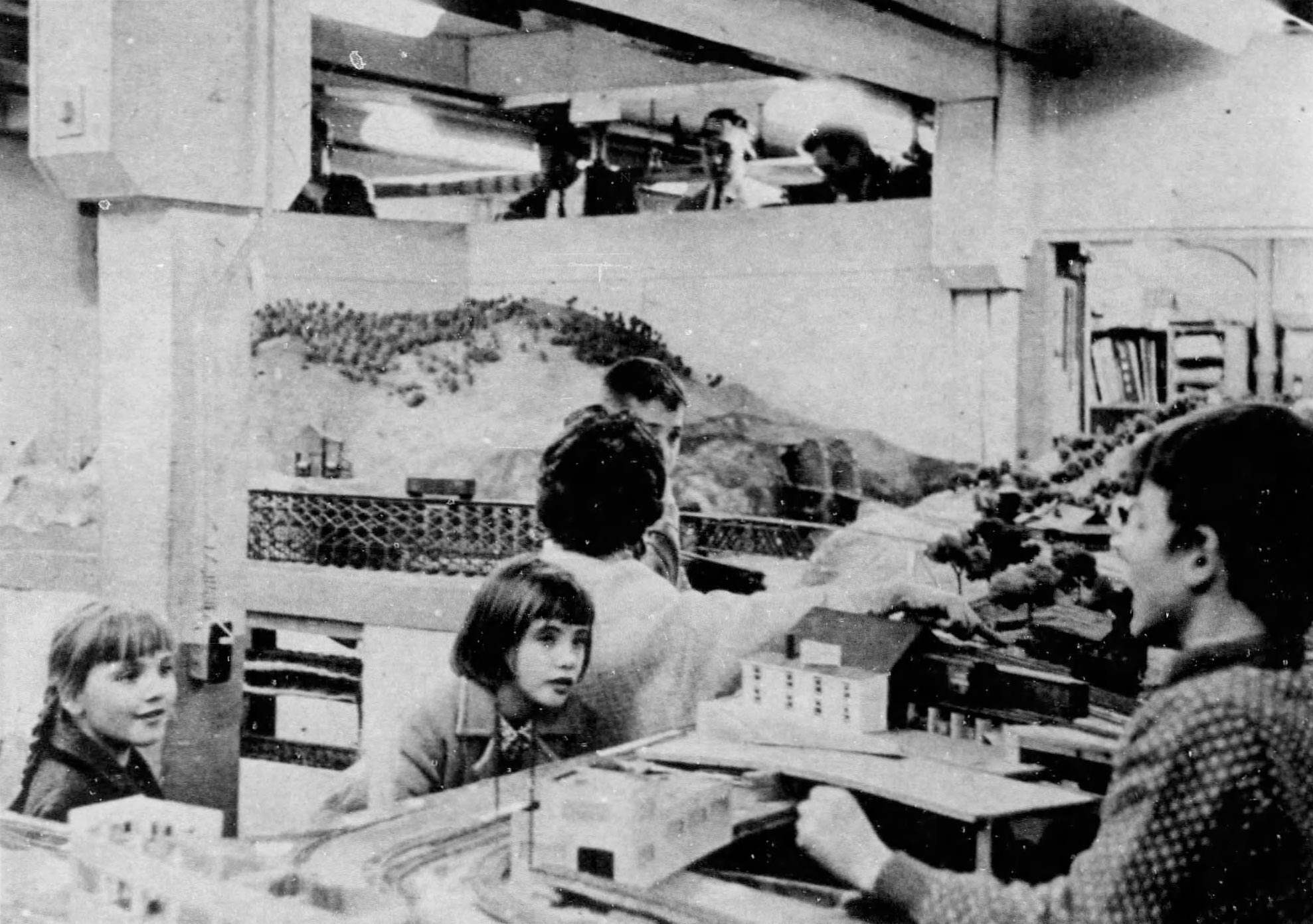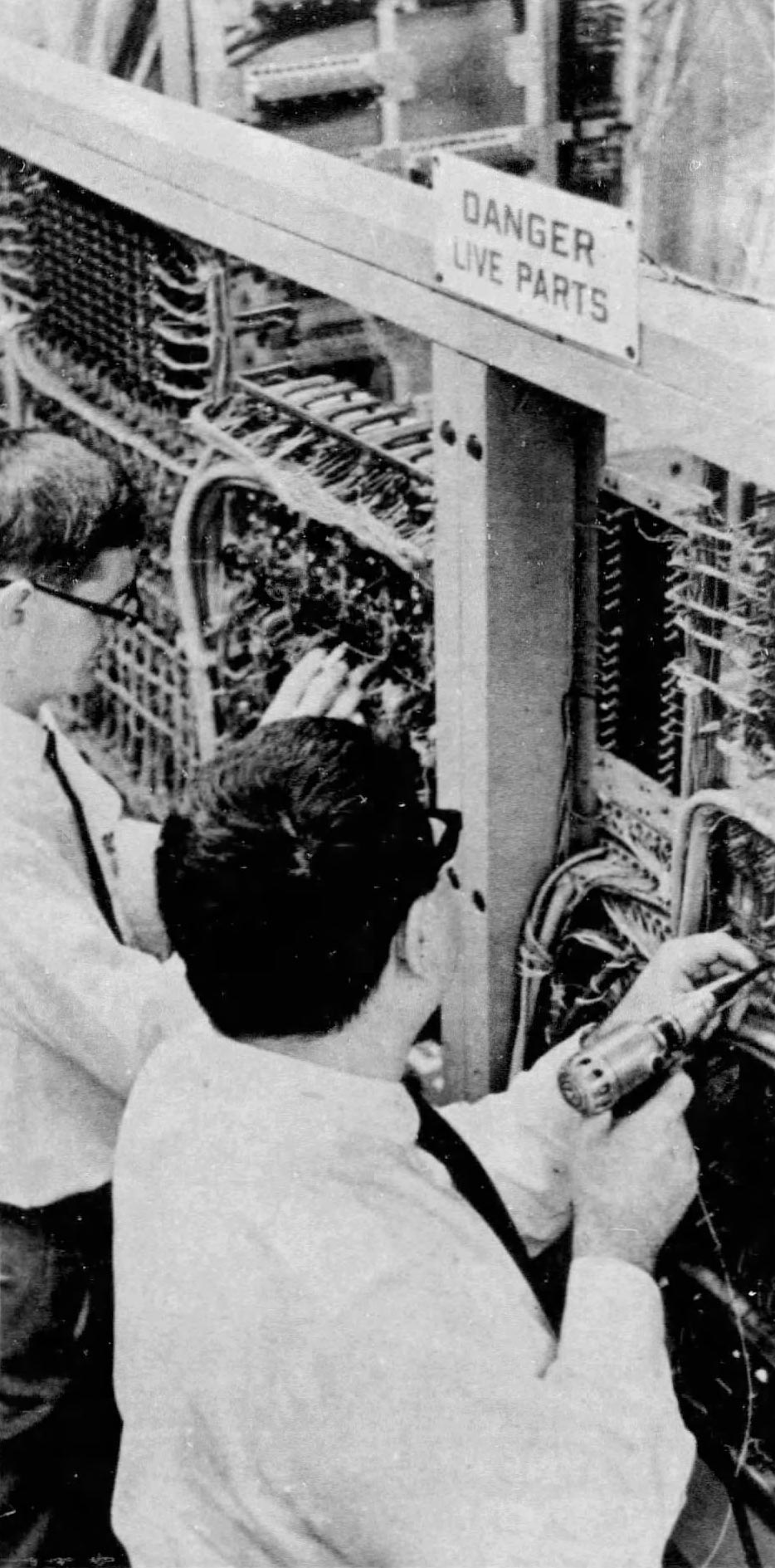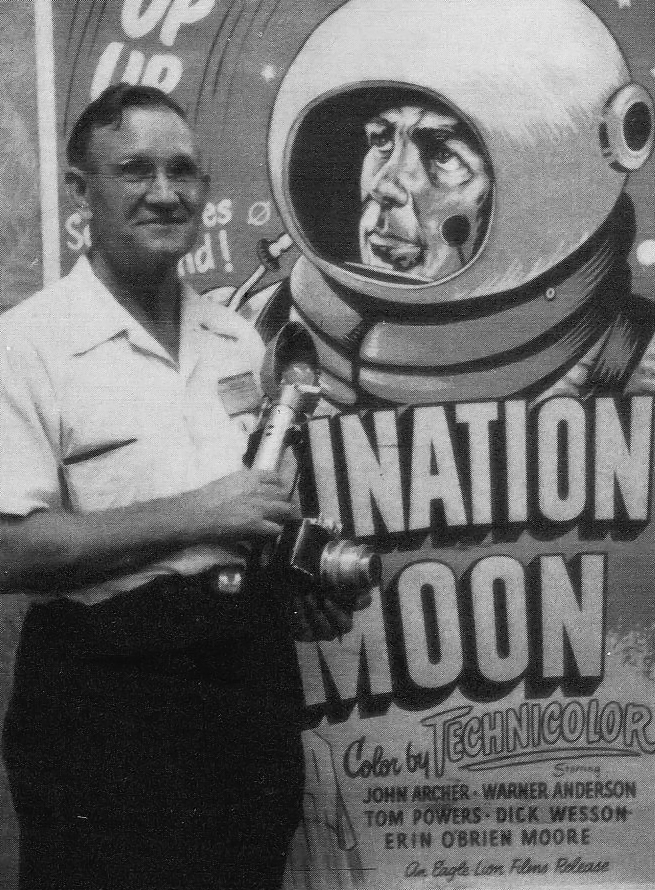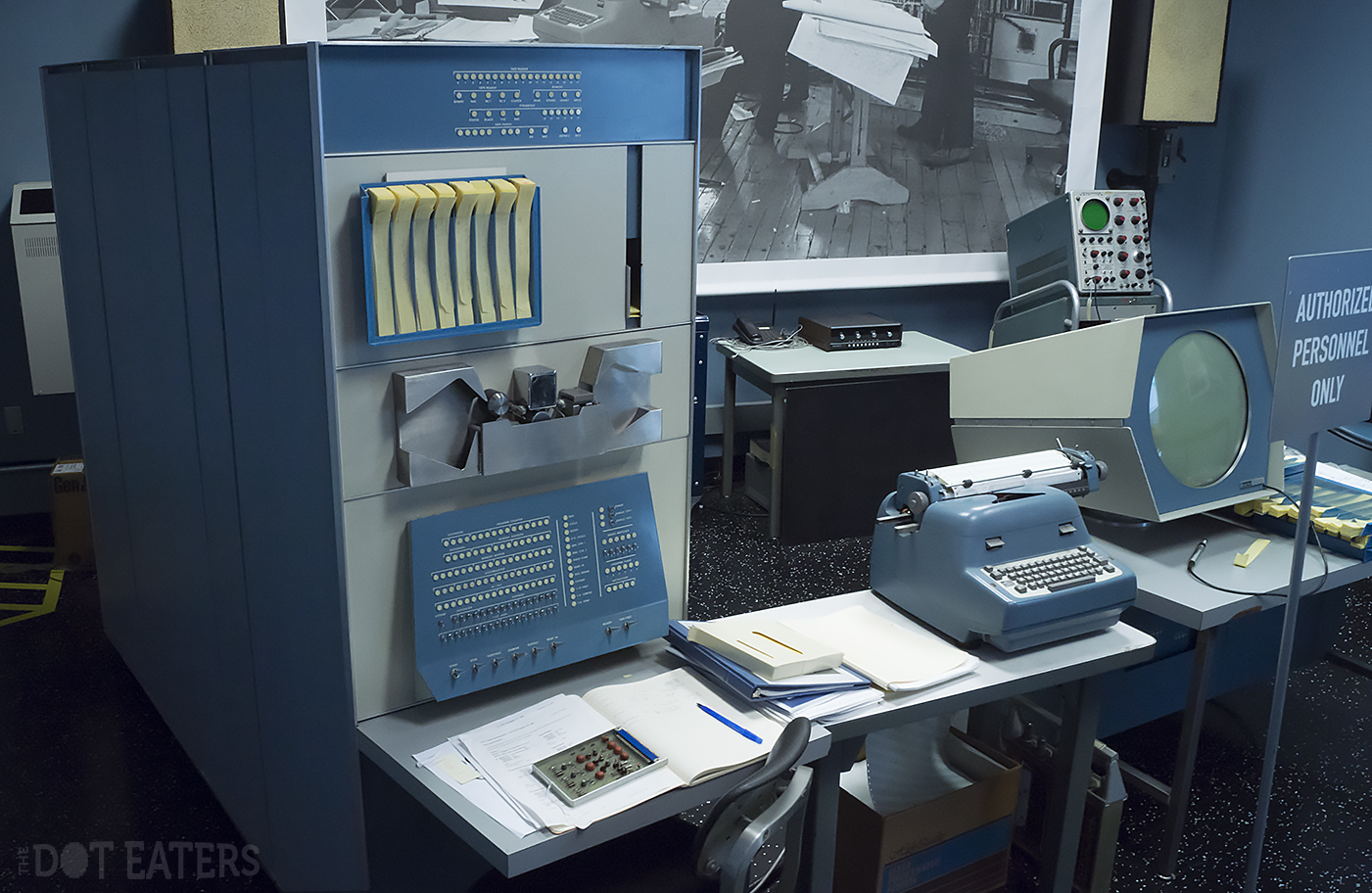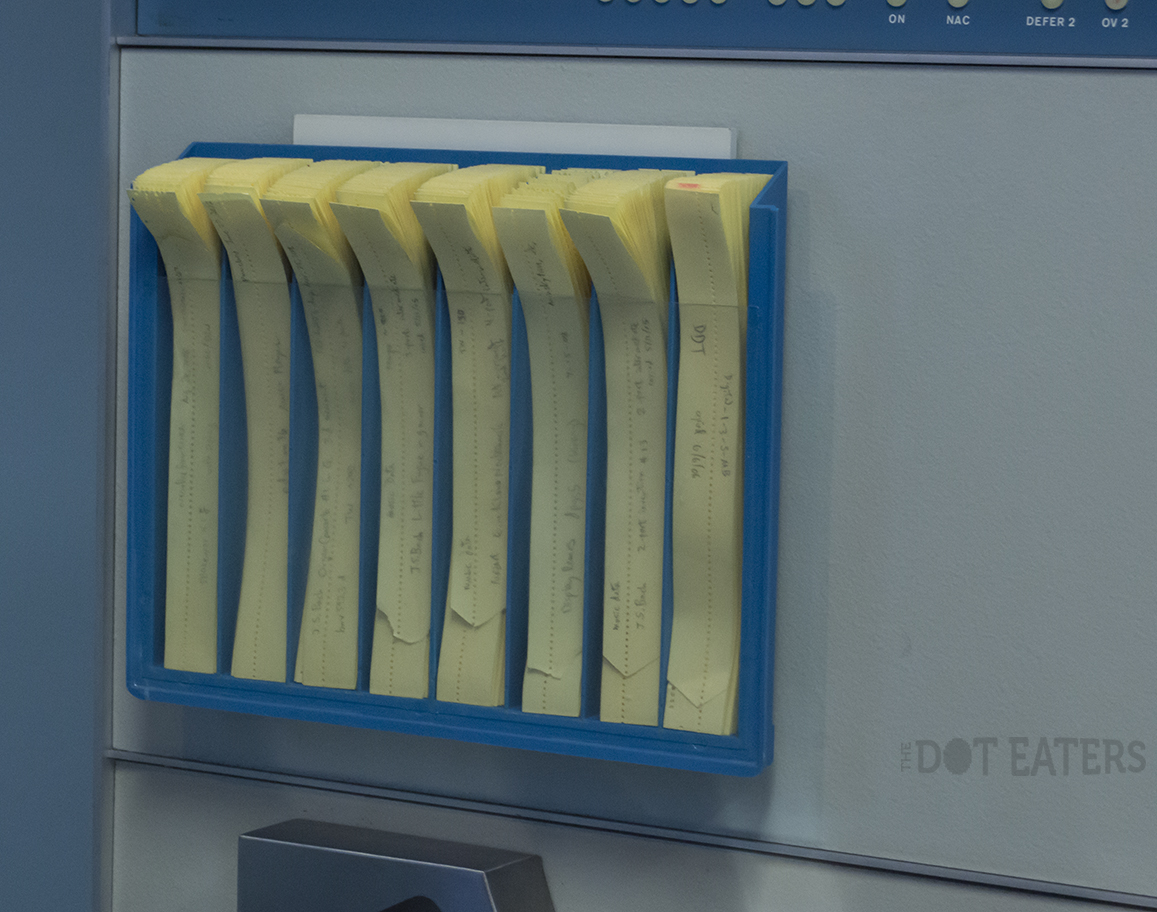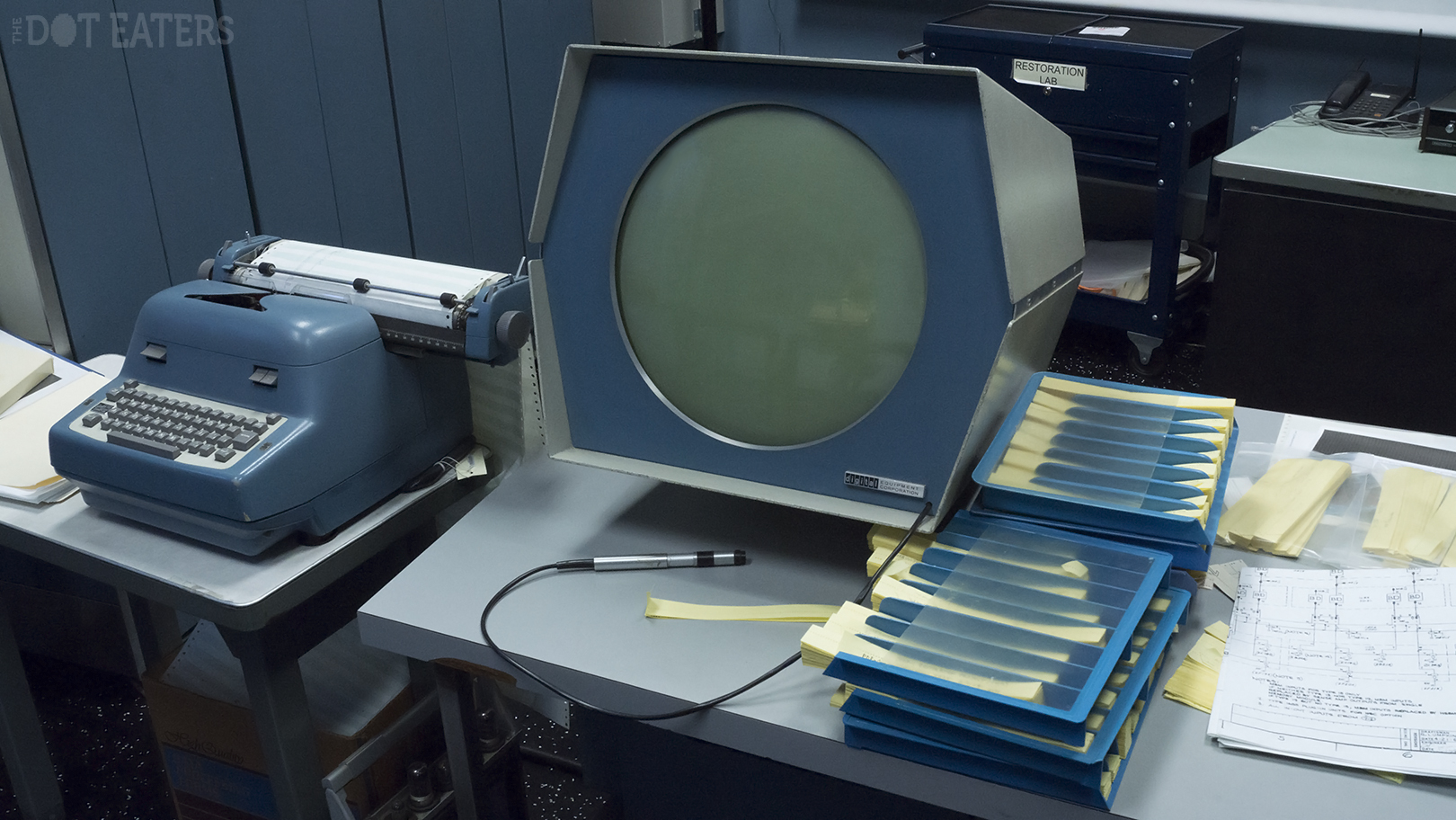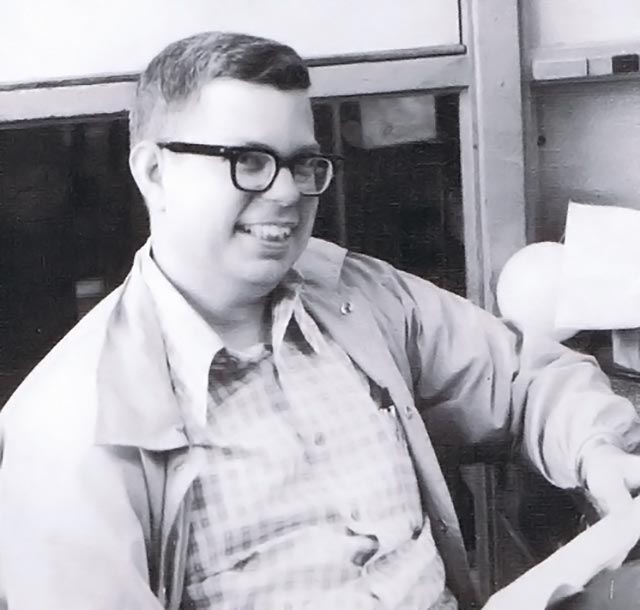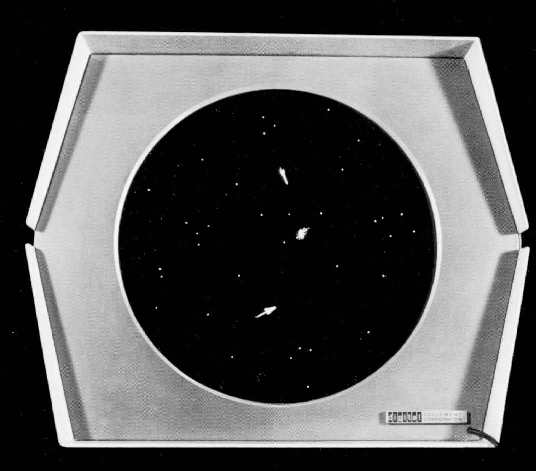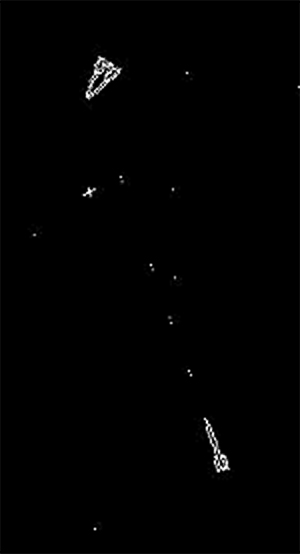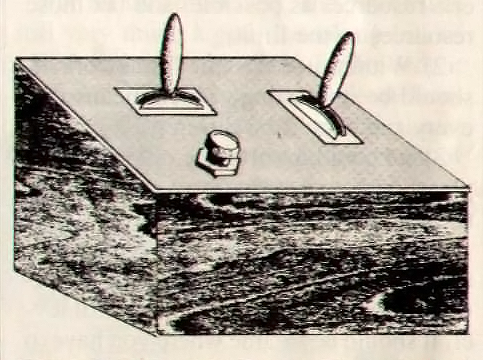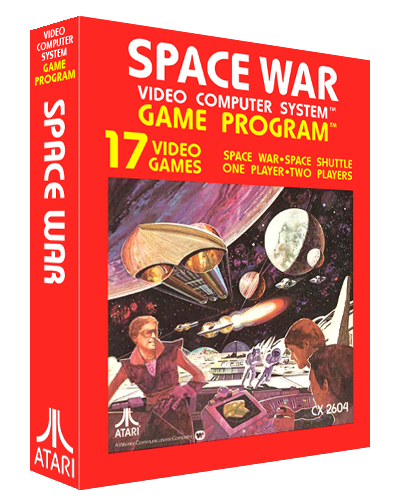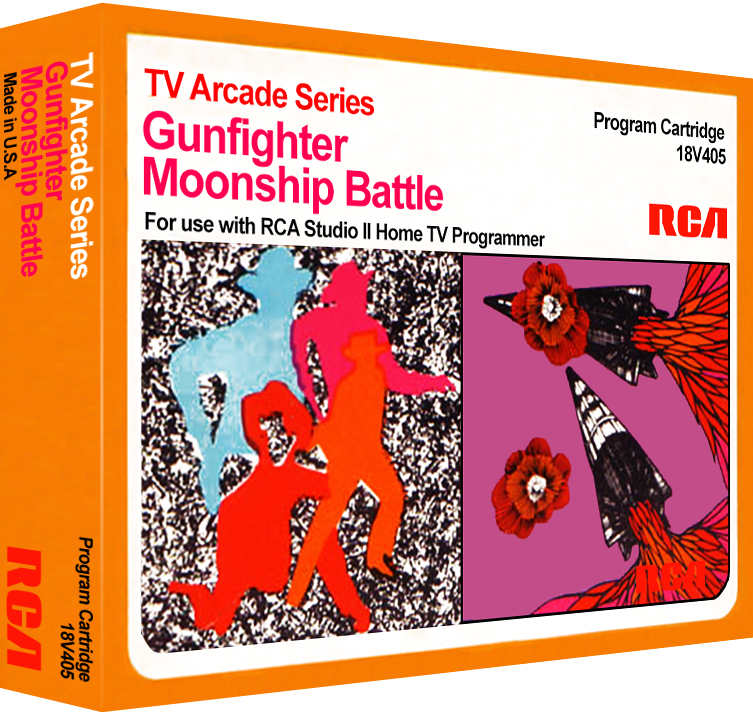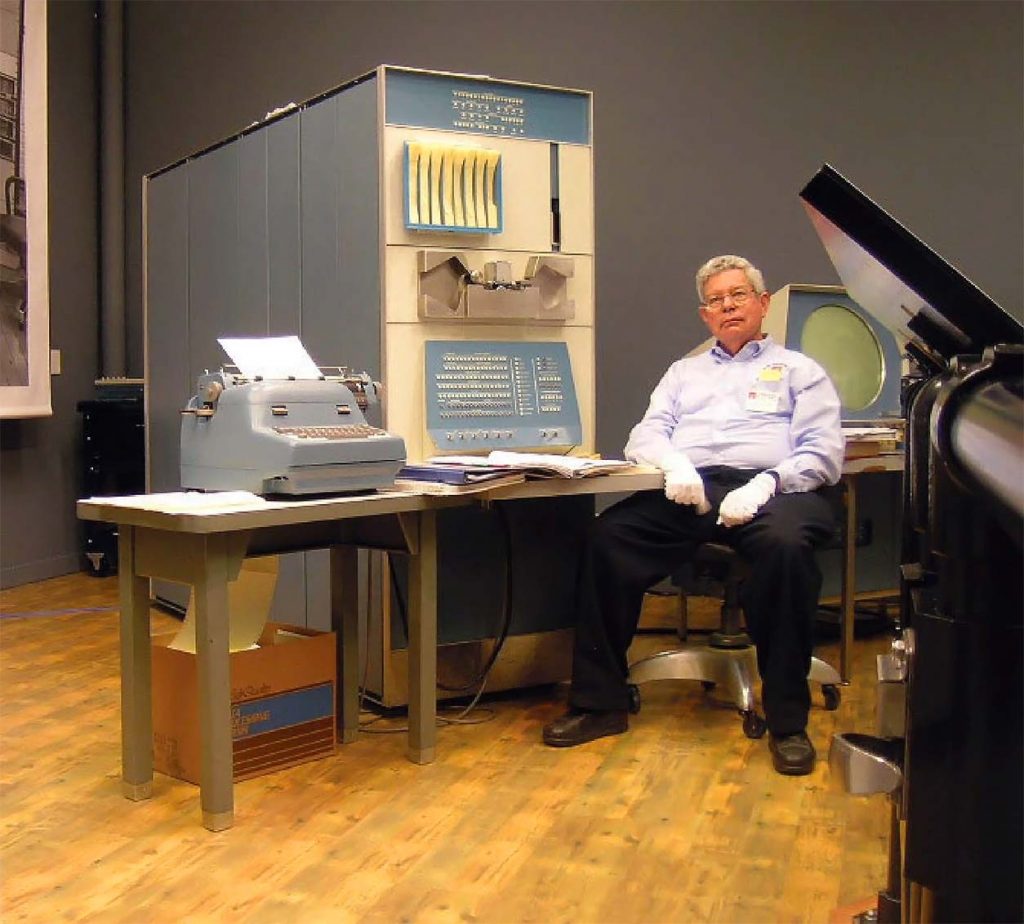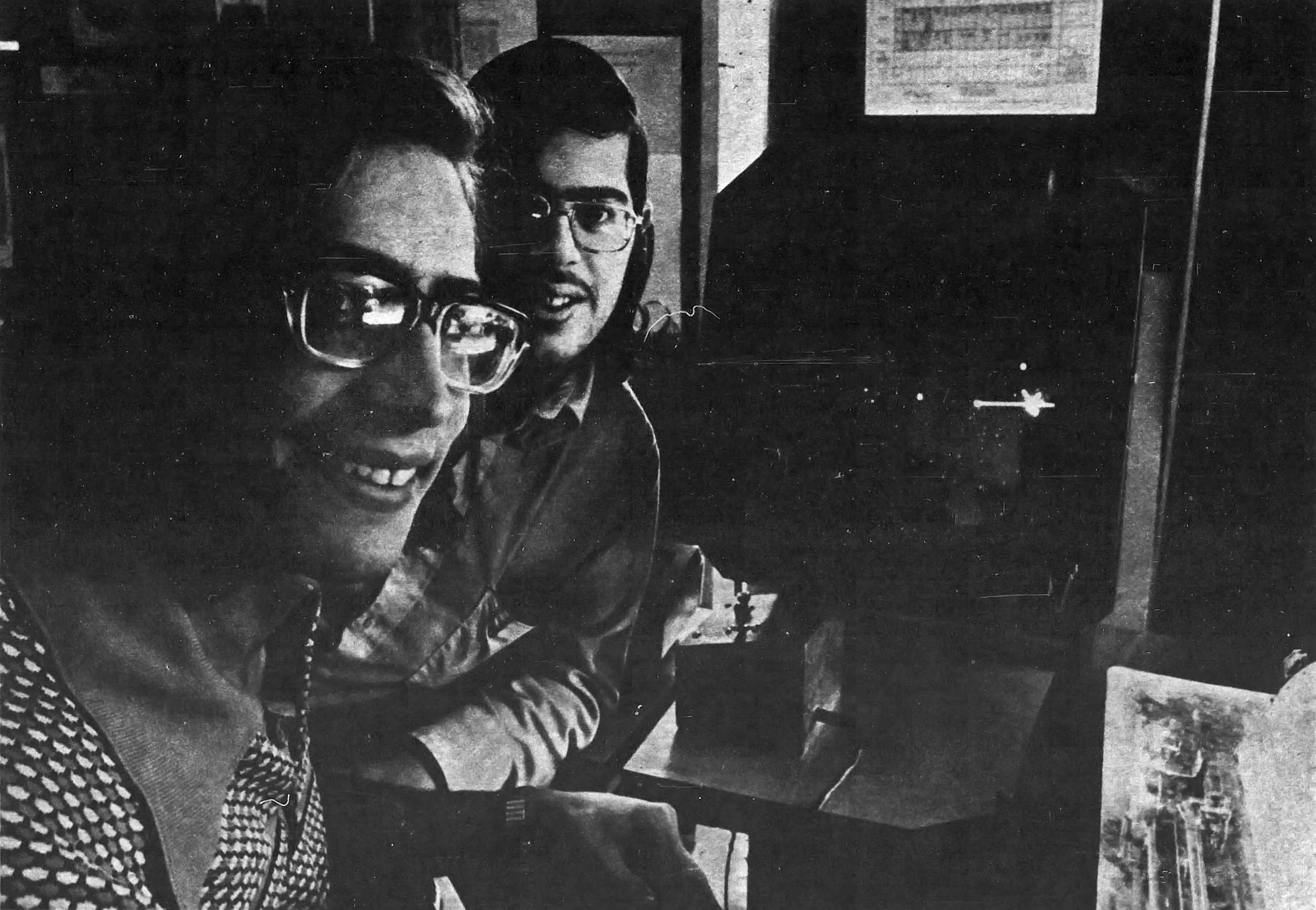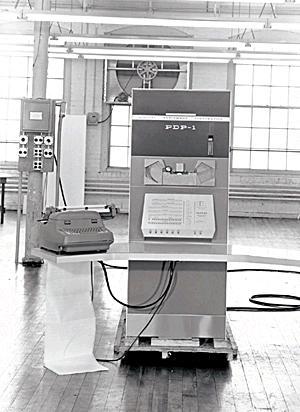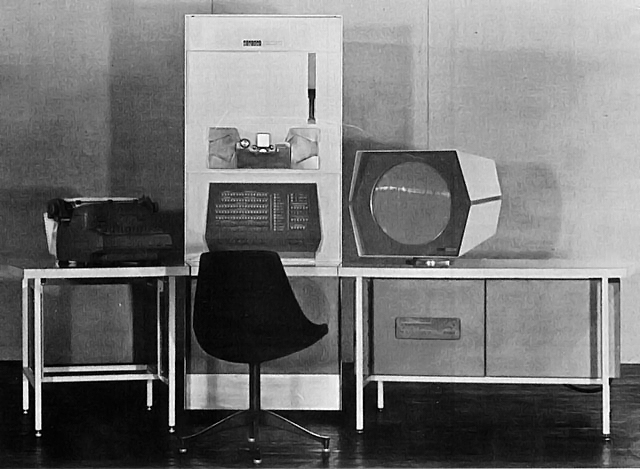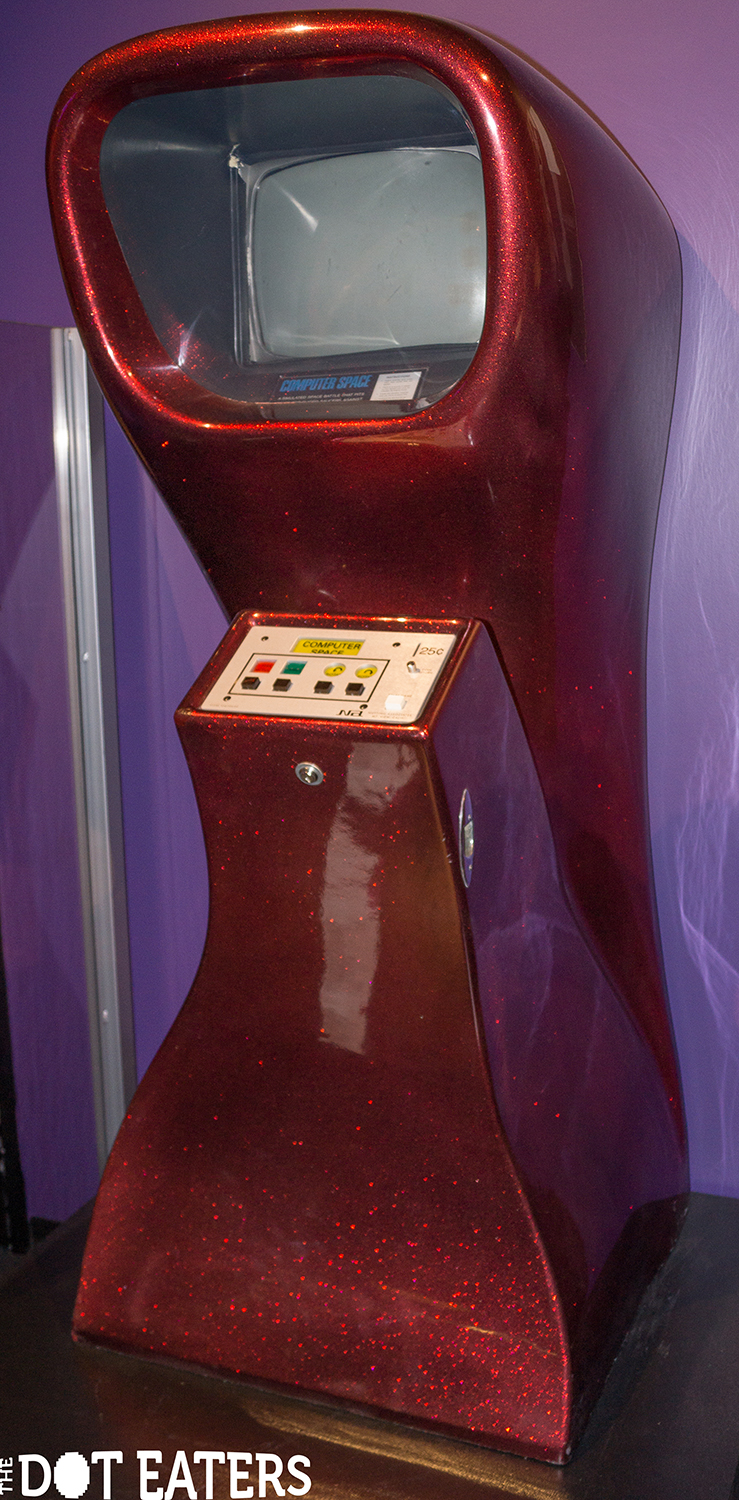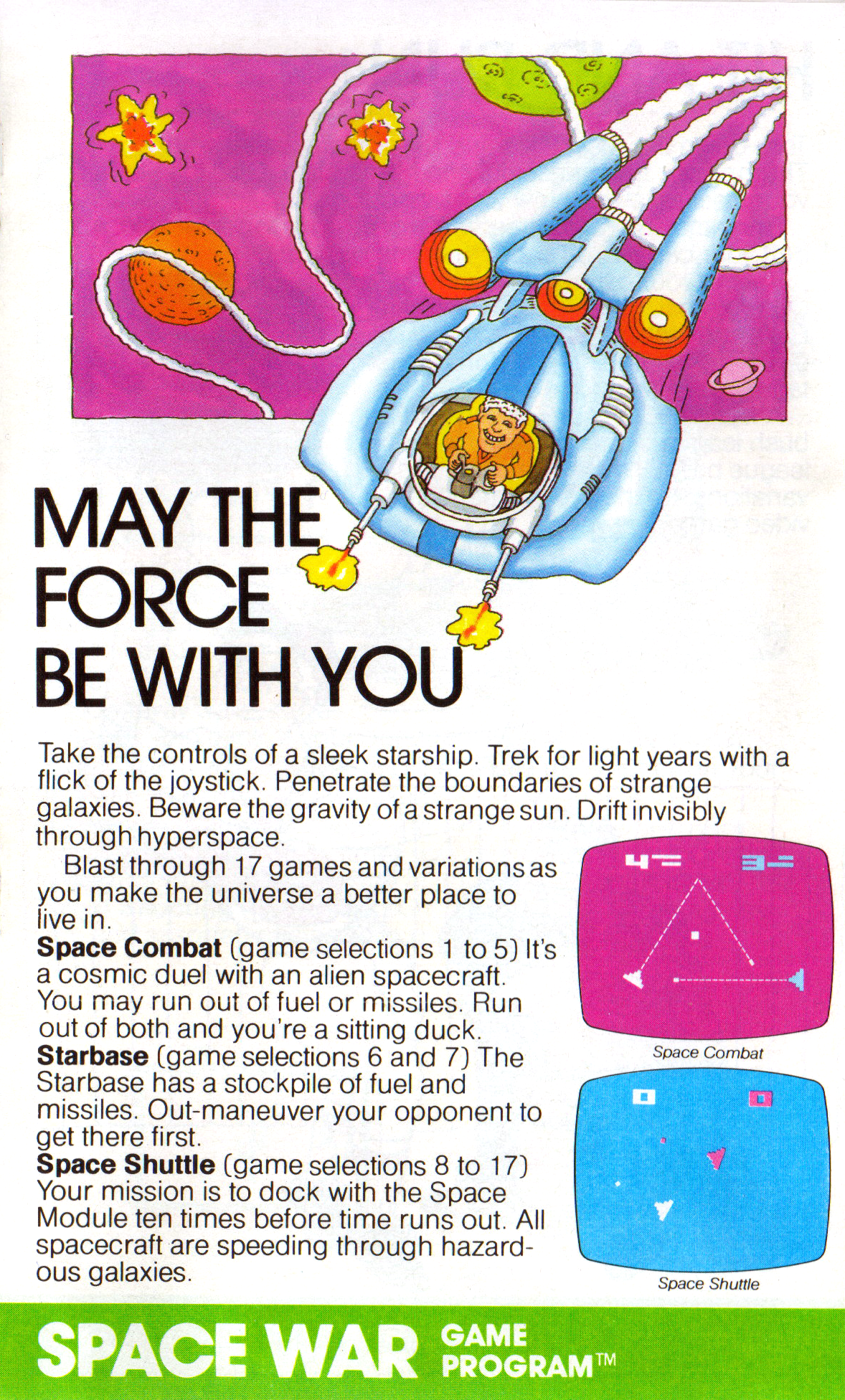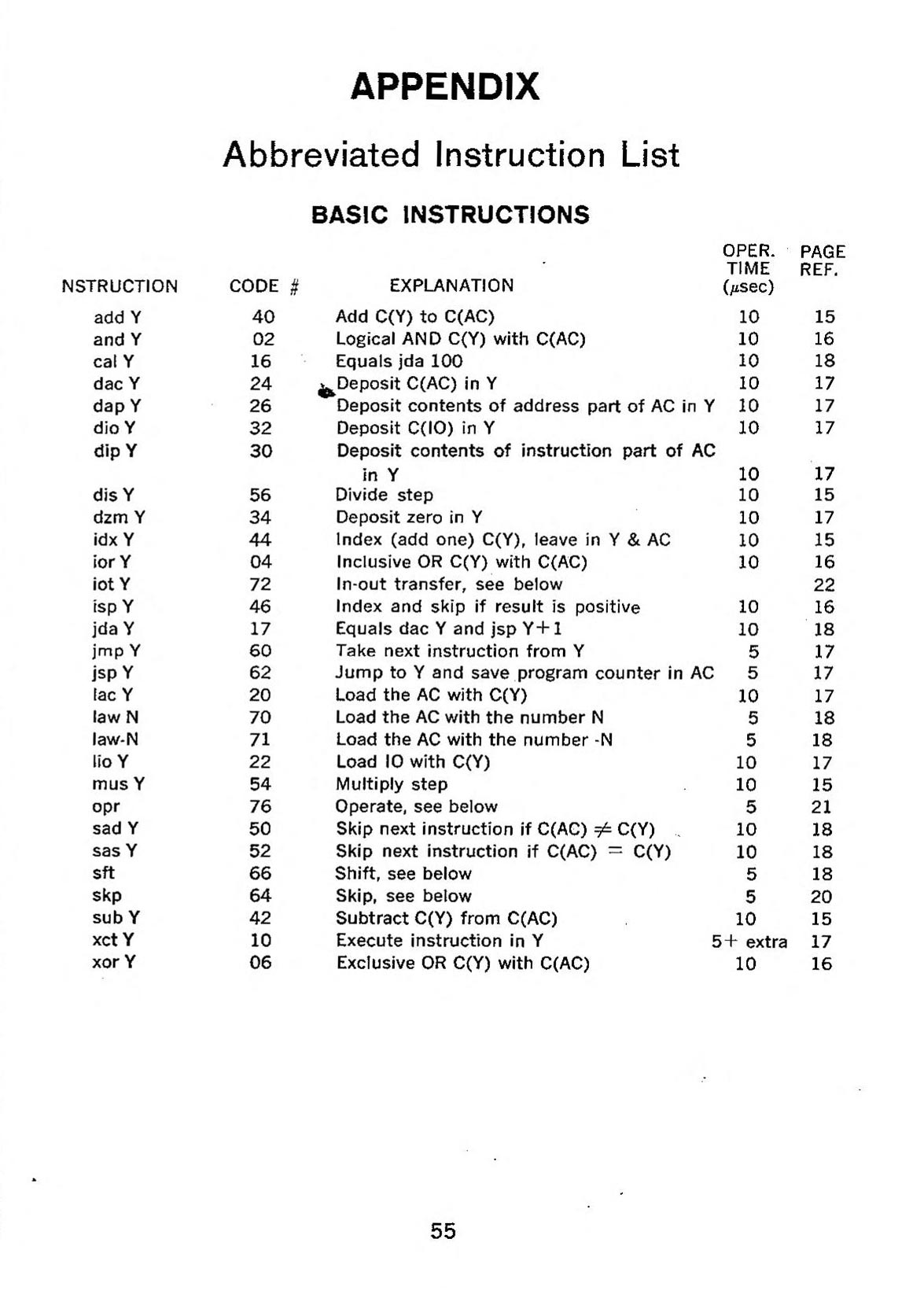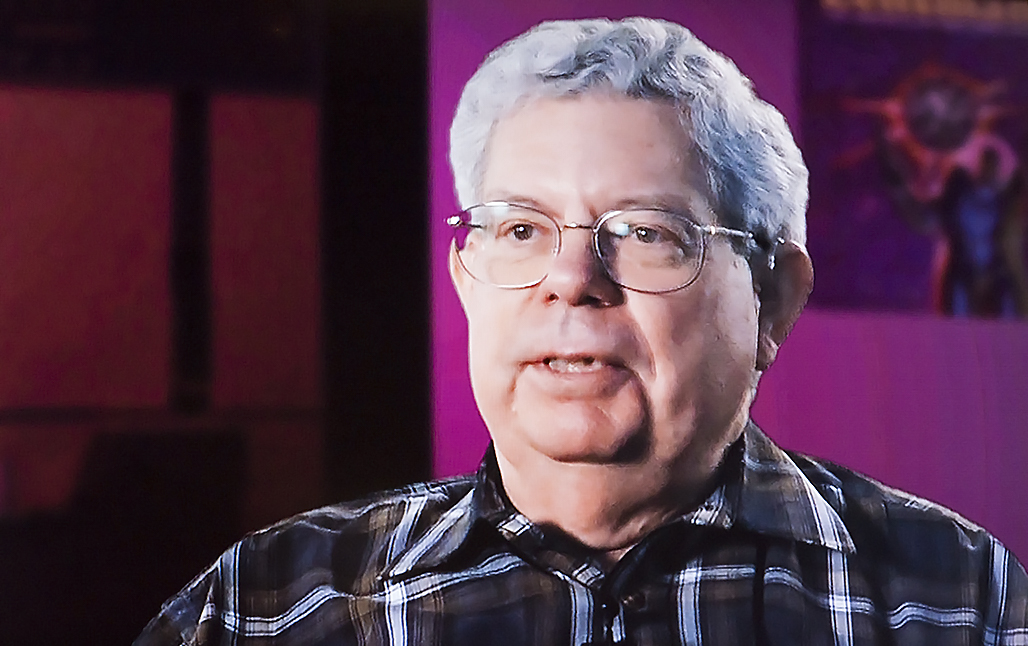From Whence Spacewar! Came: MIT and Crazy Trains
From humble settings did the creators of Spacewar! come. At the Massachusetts Institute of Technology in 1961, street address 18 Vassar St., Cambridge MA., sits a ramshackle structure shaped like a drunk’s rendition of the letter ‘E’… or a mad tuning fork. Named Building 20, it was initially built during WWII as a temporary structure on the campus to hold the Radiation Laboratory, a group at MIT that had developed airborne RADAR sets for U.S. warplanes….and had counted William Higinbotham as one of its scientists, a man who later developed in 1958 what could be considered the original video game, Tennis for Two.
Inside Building 20 in 1961 dwells a group of hardcore nerd “hackers” who belong to the Tech Model Railroad Club, an organization first established in 1947. On the 2nd floor of Building 20, in room 20E-214 they run a 24ft. x 25ft. model train set-up, forever tinkering with the nest of wires and the 1000 relays installed under the table. For an offshoot of this group, known jokingly as the Hingham Institute (referencing a dilapidated apartment building located on Hingham St. in Cambridge that some of the members live in), activities also include obsessively discussing the space-opera novels of E.E. “Doc” Smith, considered the grandfather of the literary SF genre. They dream up wild fantasies of special-effects-ridden movie sequences based around the writer’s Skylark and Lensman novels, containing descriptions of vast interstellar spaceship battles. Thus is the environment set for Spacewar!
Developing Spacewar: The Theory of Computer Toys
Having kudged the complicated relay system for their hopped-up train routes from discarded telephone system components, it’s a natural migration for these hackers from the wires and switches of their train set to the wires and switches of early mainframe computers. Eventually word comes down that MIT’s aging transistorized TX-0 computer, located in Building 26 on the second floor Research Laboratory of Electronics (RLE), is getting a slick new companion: a donation from Digital Equipment Corporation of their new, relatively svelte PDP-1; PDP standing for Programmed Data Processor. Not only is this new “mini”-computer sexily compact, it also revolutionizes the computer industry by allowing a single programmer in front of its control panel to have complete access to the processor, as opposed to the prevalent idea of time-sharing computer power. Previous CRT monitor display demonstration programs (like Tennis For Two at Brookhaven Labs, they are developed for public open house purposes) for the TX-0 had consisted of the aptly-named Bouncing Ball, Mouse in the Maze (users built mazes for electronic mice to run around in), and the venerable game Tic-Tac-Toe. A TMRC brainstorming session is called to create a truly taxing demo program for the enhanced capabilities for the PDP-1. All present are around 25 years old: Wayne Witanen and J. Martin Graetz, along with a 23 year-old math major from Dartmouth named Steve Russell, an AI specialist known as ‘Slug’ by his buddies due to his tendency to procrastinate. The group of hackers who would develop this amazing demonstration of computer gaming are products of both the department at MIT handling the fabled TX-O mainframe computer, one the first of such beasts to eschew vacuum tubes and be fully transistorized, and the equally odd-ball crew at the Artificial Intelligence Lab. During bull-sessions about the demo program at the Hingham Institute, they develop the basic underpinnings of what will become Spacewar! – the Theory of Computer Toys: 1) It should demonstrate the computer’s resources and tax those resources to the utmost. 2) It should be interesting, therefore different every time it is run. 3) It should actively involve the user, as in it should be a game. Recalling E.E. Smith’s epic space battles, In summer of 1961, the group forms the idea of pitting two spaceships with limited fuel supplies against each other in a missile duel. The program becomes Spacewar!, with Russell as main programmer. Little does he know that his program would eventually result in the loss of computer productivity estimated into the millions of dollars.
Waging Spacewar!
Hoping to spur Russell’s development of the game, other programmers throw him aid, including a sine-cosine routine procured from Digital Equipment’s users library by Alan Kotok. Getting underway with Spacewar!, Russell creates two ships, called the wedge and the needle according to their shapes, that are rendered in rough outline graphics. They are controlled by switches on the front panel of the PDP-1: a left-right toggle switch to rotate the ships clockwise and counterclockwise, and another toggle switch to set direction movement forward or back; and a switch to apply thrust to your ship. Each vessel commands a store of 31 torpedoes they can hurl at their opponent during a match, emanating from the nose of their ship. Russell adds in some random unreliability with the operation and trajectory of players’ shots, but this proves to be so unpopular with players that he quickly drops this “feature”.
Click the button to play the seminal Spacewar! on the PDP-1. Hold both LEFT CTRL and ENTER to load game. For Wedge ship use A and S to turn, D to thrust, F to fire and Z for hyperspace. For Needle ship, left and right arrow to turn, up arrow to thrust, down arrow to fire, / key for hyperspace
Working for almost six months, logging 200 man-hours, by spring of 1962 Russell has an initial version of what he titles Spacewar! completed. Russell’s compatriots add their own spice to the proceedings with later revisions of the program. For example, a very realistic star field backdrop program called Expensive Planetarium is added by Peter Samson. Dan Edwards develops the accurate gravity effects in the game, centred around a bright sun at the center of the screen, the gravity well of which would draw careless pilots in to their doom. Graetz develops the hyperspace feature, activated via another switch on the front of the PDP-1. This can be thrown forward by a panicked player to get out of a scrape and into the hands of fate by disappearing their ship, which then appears randomly elsewhere on the screen. In order to deter spacefarers from relying too much on this crutch, multiple uses of hyperspace steadily increase the odds that your ship will explode when coming out of it. With the added revisions, this “final” version of Spacewar! by the original MIT instigators weighs in at a total of 9K.
SPACEWAR! IS HEREBY BANNED.
Fed into the PDP-1 via paper tape input and viewed on the attached CRT screen, Spacewar! causes a sensation with its debut at MIT’s annual Science Open House that May, and a scoring system must be introduced to limit people’s time at the control switches used to play. History is also made by Kotok and fellow Spacewar addict Bob Sanders, who are sick of the elbow fatigue caused by holding the toggle switches on the PDP-1 to control the action. Raiding the spare-parts bin of the TMRC, they put together two wooden control boxes, wired directly into the computer. With dedicated switches and buttons to control the game in hand, these could be considered the first gaming joysticks. The fervor over the game among nerds at MIT causes the school to take the step of banning Spacewar!, outside of lunch breaks and after work hours. Sick of cleaning up the beer cans and other trash after all-night marathon sessions at the computer by students from all over the campus destroying each other’s spaceships, MIT administration eventually orders all copies of Spacewar! destroyed.
Of course, a couple of copies of Spacewar! survive the great purge and paper-tape backups quickly spread to other educational facilities in the U.S…. who then equally seek to limit or ban Spacewar! from their computer centres. On a more positive note, PDP-1 maker DEC uses the program to demonstrate the capabilities of the PDP-1 to new clients and includes it free with every installed system.
Free Range Warfare: The Impact of Spacewar
Once again, just like Tennis for Two creator William Higinbotham, Russell doesn’t seek to copyright or patent his work. Not only would seeking royalties contradict the hacker ethos revered by these early computer geniuses, but also pertinent is the fact that the system Spacewar! is running on is hardly a consumer product: it’s the size of three refrigerators and costs $120,000. On top of all that, the creators aren’t even sure if a program could be copyrighted. This open source nature of Spacewar! encourages modification: in 1969, Rick Bloome uses the PLATO computerized education platform to create a networked version of Spacewar!. In 1974, Ken Harrenstein, along with Charles Frankston and Gary Palter from MIT, among other tweaks to the program convert the wedge and needle ships into shapes closely resembling the starship Enterprise from Star Trek, and call their version Vector of Mysteries. What Paramount and NBC might think of their creation is unknown…. although this design motif will be carried forward by Larry Rosenthal when he does the same thing for one of his ships in his later Spacewar! arcade copy called, blatantly, Space Wars. Speaking of the commercial front, due to its ubiquitous nature and public domain status, the original Spacewar! will end up as the foundation of the entire video game industry and one of the most copied concepts in the medium. It inspires arcade translations such as the first commercial arcade video games, Galaxy Game and Computer Space, as well as the aforementioned vector graphics game Space Wars by Rosenthal and Cinematronics, as well as Atari’s answer to that game, Orbit, and even on to the company’s smash hit Asteroids. The Spacewar! concept also materializes early on in home video games for systems like the Channel F and the Atari VCS. ![]()
Click button to play Atari Spacewar! and Space Wars arcade knock-off Orbit

L-R: Alan Kotok, Steve Russell and J.M. Graetz play Spacewar at the Boston Computer Museum, undated photo
Sources (Click to view)
Nardi, Wendy. “Tiny Trains, Art, Music.” The Boston Globe 03 May 1990: 3. Newspapers.com. Web. 28 July 2021. The club [TMRC] is at MIT, Room 20E-214, Building 20, 18 Vassar St., Cambridge.
Campbell, Robert. “End of the ‘Magic Incubator’.” The Boston Globe 05 June 1998: D1+. Newspapers.com. Web. 28 July 2021. Image of a corridor in Building 20. Photo by Wendy Maeda
Harris, Frank. “M.I.T. Students Operate Railroad That PAYS.” The Boston Globe 08 Jan. 1959: Twenty-One. Newspapers.com. Web. 28 July 2021. It was built by the students and is composed of 1000 relays. It keeps track of the position of the trains on the 24-by-25 layout… ;Tech Model Railroad Club was formed back in 1947…
“The Origin of Spacewar!”, by J. M. Graetz, reprint of 1981 Creative Computing magazine article – www.wheels.org/spacewar/creative/SpacewarOrigin.html
Lord, Deane. “Where the Trains Run on Time.” The Boston Globe 09 Jan. 1966: 8-12. Newspapers.com. Web. 28 July 2021. Images of a hilly section of the TMRC, and Alan Kotok working on TMRC relay system. Photos by David Hunsberger
Museum of Computing Magazine, “The Mouse That Roared: PDP-1 Celebration Event!”, Spring/Summer 2006 Issue, pg. 3
Video games
“PDP-1 Plays at Spacewar” – 1962 Decuscope newsletter article by D.J. Edwards and J.M. Graetz
Image of Astounding cover, and E.E. Smith from Starlog, “The Worlds of E.E. ‘Doc’ Smith”, by David Kyle, pgs. 45-46, Feb 1989
Colour image of the PDP-1 computer and peripherals, and Steve Russell, taken by William Hunter at the Computer History Museum, Mountain View CA
Kent, Stephen L. “The Great Videogame Swindle?” Next Generation, Nov. 1996, pp. 64–229. In the summer of 1961, Digital Equipment donated its latest computer to MIT, the PDP-1 (Programmed Data Processor-1).;When Russell confided to Kotok that he needed a sine-cosine routine to get started, Kotok went directly to Digital Equipment to get it.’Eventually Allen [sic] Kotok, came in and said, ‘All right, here are the sine-cosine routines, now what’s your excuse?’ He’d gotten it out of the users library.” ;It took Russell nearly six months and 200 man-hours to complete the first version of the game, a simple duel between rocket ships.;Russell called his game Spacewar ;Tired of having sore elbows, Alan Kotok and Bob Sanders scrounged parts from the Tech Model Railroad Club and assembled remote controllers that could be wired into the computer. These remotes were easier to use than the PDP-1’s native controls, they had dedicated switches for every Spacewar function, including hyperspace buttons. This was the forerunner to the joystick.
Staples, Betsy. “Happy Birthday Spacewar!” Comp. Sketch The Cow. Atari Explorer Mar. 1988: 31-32. Internet Archive. 29 Oct. 2020. Web. 11 Aug. 2021. Using only about 9K of computer memory, Martin “Shag” Graetz, Stephen “Slug” Russell, and Alan Kotok created Spacewar…
“Spacewar” – 1972 Rolling Stone article by Stewart Brand
Eimbinder, Jerry, and The History of How We Play. “TV Game Background.” Gamestronics Proceedings, Jan. 1977, pp. 159–165. Internet Archive, archive.org/details/GamtronicsProceedings/page/n159.Research buffs estimate that Russell’s ingenuity cost companies possessing computers several million dollars during the following three or four years;
Image of the Spacewar! control box from reprint of same article in Creative Computing Video & Arcade Games, pg.84, Vol. 1 No. 1, Spring 1983
Jordan, Gerald B. “Already, a Museum of the Computer Age.” The Philadelphia Inquirer 15 Nov. 1984: 1-C-1-C. Newspapers.com. Web. 27 July 2021. The invention [Spacewar!] was not copyrighted, he [Martin Graetz] said, because the idea for it had been widely distributed among engineering students and there seemed to be little mass appeal for it since the computer to run it at the time cost $125,000. Besides, Graetz added “we weren’t sure a program was something that could be copyrighted.”
Sauter, Eric. “Fighting a Spacewar in the No-Name Lab.” The Boston Globe 21 Apr. 1974: 6. Newspapers.com. Web. 26 July 2021. Image of Ken Harrenstein and Gary Palter in front of Spacewar! Photo by Ed Fitzgerald. Other info: Welcome to Ken Harrenstein’s ‘Star-Trek’ game, folks. Par of the credit for this computer marvel goes to a couple of Ken’s accomplices, Charles Frankston and Gary Palter. ;There is also a change that you’ll blow up coming out of hyperspace anyway. The first time you use it as an evasive action, the changes are one in eight that you’ll explode. The second time you use it, the changes are one in seven and so on. ;”in one of the older computer labs,” Mike Beeler said, “students could come in and sign up for computer time….They would wreck the place playing Spacewar. In the morning there’d be beer cans and litter all over the place. So after one particularly bad evening they finally decided to end it. They destroyed all the copies of the Spacewar program.” He adds: “Except one or two, of course.” ;I have a copy of the print-out for Ken’s modified Spacewar game. It is called, not surprisingly, the Vector of Mysteries.;This computer craziness began at the MIT Electrical Engineering Department back in 1961-62 with a 23-year-old Dartmouth math major named Steve Russell.
Electronic Games, “Players Guide To Electronic Science Fiction Games”, pgs. 35 – 45, Mar. 1982
Hays Daily News, “Forty years of change since ‘Spacewar'”, by John D. Montgomery, pg. A4, Mar. 31, 2002
Phoenix: The Fall and Rise of Videogames, by Leonard Herman
The Museum of Science, Boston – www.mos.org/index.html
Chris85, comp. “The History of the World (Of PC Gaming): Part I.” Computer Power User June 2013: 77-82. Internet Archive. 6 Dec. 2013. Web. 17 Jan. 2022. Image of Steve Russell sitting with the PDP-1 computer at the computer history museum, Mountain View CA ,2013Chris85, comp. “The History of the World (Of PC Gaming): Part I.” Computer Power User June 2013: 77-82. Internet Archive. 6 Dec. 2013. Web. 17 Jan. 2022. Image of Steve Russell sitting with the PDP-1 computer at the Computer History Museum, Mountain View CA, 2013
Eimbinder, Jerry, and The History of How We Play. “TV Game Background.” Gamestronics Proceedings, Jan. 1977, pp. 159–165. Internet Archive, archive.org/details/GamtronicsProceedings/page/n159. Image of Galaxy Game installed at Tressider Union Coffeehouse, 1977, photo by Liane Enkelis
Digital Computing Timeline – www.digital.com/timeline/timeline-57-61.html
Electronic Nation, by Steven L. Kent – www.videotopia.com/edit2.htm
videogames.com’s History of Video Games – www.videogames.com/features/universal/hov/index.html
Digital Equipment Corporation. PDP-1 Manual. Maynard, MA: Digital Equipment Corporation, 1962. Print. Abbreviated Instruction List
Staples, Betsy. “Happy Birthday Spacewar!” Comp. Sketch The Cow. Atari Explorer Mar. 1988: 31-32. Internet Archive. 29 Oct. 2020. Web. 11 Aug. 2021. 1988 image of JM Graetz and Steve Russell posing with Spacewar!
Markoff, John. “Spacewar Launched Video Game Era.” Chicago Tribune 04 Mar. 2002: 4-3. Newspapers.com. Web. 28 July 2021. Image of Steve Russell at controls of PDP-1 computer, photo by Peter DeSilva
Scott, Jason, comp. “A History of Computer Games.” Computer Gaming World Nov. 1991: 16-26. Internet Archive. 18 Mar. 2017. Web. 22 Nov. 2022. Image of Alan Kotok, Steve Russell and J.M. Graetz playing Spacewar, Russell facing camera. More info: ..in the summer of 1961…he and some friends hit upon an idea for bringing E.E. “Doc” Smith’s pulp science fiction novels…to the computer. ;Each ship had an inventory of 31 torpedoes… ;Knowing that real torpedoes do not have a 100% success rate, Slug decided to give the space torpedoes a certain failure rate and to add randomality to their respective trajectories and time of detonation. His friends hated the new version…Slug changed things back…
External Links (Click to view)
1998 video about MIT’s vaunted Building 20, hang out for Spacewar! creators TMRC, “The Magical Incubator”, at infinite.mit.edu
A look back at Digital Equipment Corp., makers of the PDP-1 that originally ran Spacewar!, at boston.com
Spacewar! Original 1962 game code running on PDP-1 emulator in Java
The works of E.E. Smith on Scribd










